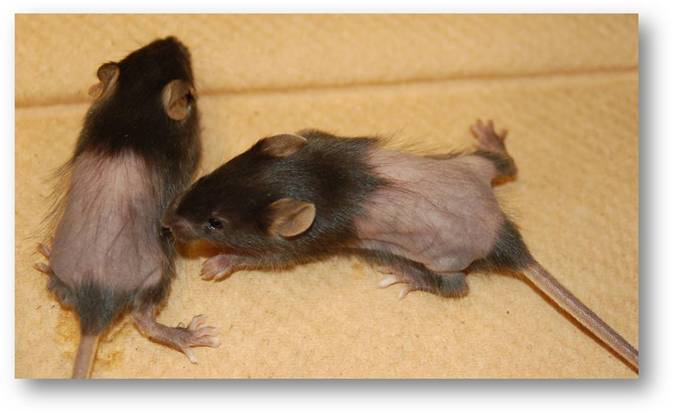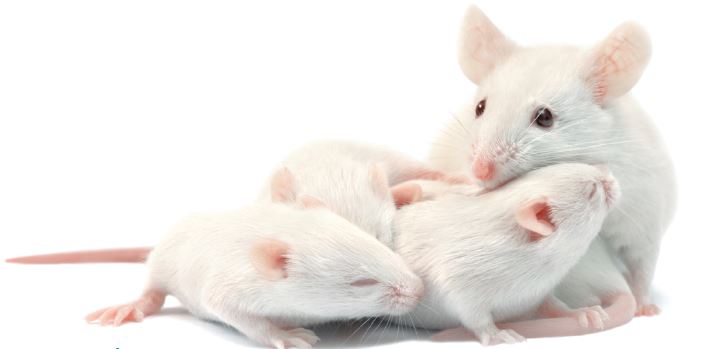Barbering is a complex abnormal repetitive behavior associated with hair loss, commonly seen in laboratory mice, who pluck fur and whiskers from cage-mates, pups or themselves, leaving patches of hair loss. Self-barbers pluck fur from their own chest, belly, genitals, and the inside or outside surface of their forearms. Cage mate barbering is distinguished by denuded face around the whiskers, dorsal face (including the eyes), between the ears, the dorsal neck, back and rump (1).
Although whiskers are the most common area plucked, not all mice pluck whiskers. Whiskers in mice are the most important tactile apparatus, similar to fingers in humans, and plucking can lead to sensory impairment severely disturbing neurological and metabolic development. This behavior, while long thought to be an acceptable dominance behavior, is in fact highly abnormal and is becoming a major welfare issue. If left unattended, barbering can lead to Ulceratis Dermatitis (UD), a skin lesion condition where the mice develop deep ulcerative wounds on their flanks, neck and ears. UD represents a serious animal welfare issue and is the most common reason for unplanned euthanasia in laboratory mice.
In a recent survey conducted by ClearH2O on AALAS members, 62% of respondents report seeing barbering behavior in their breeder cages.
DietGel® Prenatal is a dietary gel supplement for breeders during pregnancy and lactation. It contains flax seeds that allow foraging to reduce stress, and are rich in antioxidants to reduce oxidative stress. The empty cup is often left in the cage as the mice use it as enrichment.
Inspired by AALAS webinar of January 14, 2020 “Barbering and Ulcerative Dermatitis: Myths, Management, and Welfare” – Joseph Garner.
To try a sample of any of ClearH2O product, simply fill out a sample request !
(1) Barbering (Fur and Whisker Trimming) by Laboratory Mice as a Model of Human Trichotillomania and Obsessive-Compulsive Spectrum Disorders - Garner 2004 PMD 15134369
(2) Hair-nibbling and whisker-trimming as indicators of social hierarchy in mice Long 1972 PMD 4677163
(3) Social and husbandry factors affecting the prevalence and severity of barbering (‘whisker trimming’) by laboratory mice - Garner 2004
(4) Environmental Enrichment Reduces the Likelihood of Alopecia in Adult C57BL/6J Mice - Bechard 2011 PMD 21439209
(5) A "Pedi" Cures All: Toenail Trimming and the Treatment of Ulcerative Dermatitis in Mice - Adams 2016 PMD 26735497
(6) Antioxidant Therapies for Ulcerative Dermatitis: A Potential Model for Skin Picking Disorder - George 2015 PMD 26167859
(7) Preventing, treating, and predicting barbering: A fundamental role for biomarkers of oxidative stress in a mouse model of Trichotillomania - Giovana 2017 PMD 28426681
Although whiskers are the most common area plucked, not all mice pluck whiskers. Whiskers in mice are the most important tactile apparatus, similar to fingers in humans, and plucking can lead to sensory impairment severely disturbing neurological and metabolic development. This behavior, while long thought to be an acceptable dominance behavior, is in fact highly abnormal and is becoming a major welfare issue. If left unattended, barbering can lead to Ulceratis Dermatitis (UD), a skin lesion condition where the mice develop deep ulcerative wounds on their flanks, neck and ears. UD represents a serious animal welfare issue and is the most common reason for unplanned euthanasia in laboratory mice.
Risk factors to barbering:
- Some mouse strains are more prone to barbering, such as C57BL/6, 129SVE, C3H
- Barbering behavior can start at puberty and increase with age.
- Females are about one-and-a-half times more likely to barber than males and breeders are approximately five times more likely to barber than stock mice. A clear example is when moms barber their pups.
In a recent survey conducted by ClearH2O on AALAS members, 62% of respondents report seeing barbering behavior in their breeder cages.
- Barbering is associated with stress and was found to be related to a number of environmental factors, including cage design, cage location, cage mate relatedness, and the presence of other barbers in the cage.
- Barbering has originally been thought to be a dominance behavior (2). However, more recent studies have shown that the relative dominance score of a mouse within its cage was unrelated to barbering, and the relative severity of hair loss on a mouse was unrelated to its relative dominance (3).
Prevention & Treatment:
- An easy screening protocol is to spray young mice with a mist of water. Risky mice engage in crazy behavior. Abnormal grooming will predict the development of barbering and UD later in life.
- You can prevent barbering behavior by providing enrichment such as shelter and nesting material (nesting pad, crinkle paper) systematically in breeding cages (4). Toys, tunnels, plastic containers, and other enrichment should be carefully added, as they might enhance male aggression.
DietGel® Prenatal is a dietary gel supplement for breeders during pregnancy and lactation. It contains flax seeds that allow foraging to reduce stress, and are rich in antioxidants to reduce oxidative stress. The empty cup is often left in the cage as the mice use it as enrichment.
- As wounds get bigger, the mouse gets scratchier. Interfering with scratching behavior by trimming the toenails of mice with UD can resolve lesions (5) . As it takes 4-8 weeks to grow the nails back, the wounds have time to heal and fur time to regrow before the nails return.
- Barbering has recently been associated with oxidative stress (6). Two powerful antioxidants N-acetylcysteine (NAC, oral delivery) and glutathione (GSH, intranasal delivery) are equally effective drugs to treat barbering and UD (7). Diet has a significant role to play in prevention and treatment of barbering and UD! However, the NAC double sulfur bond is degraded when subjected to autoclave high temperatures and irradiation, and its half-life is only a few hours. As NAC is both soluble is water and fat, MediGel® Sucralose or MediGel® Hazelnut offer easy methods of oral delivery.
Inspired by AALAS webinar of January 14, 2020 “Barbering and Ulcerative Dermatitis: Myths, Management, and Welfare” – Joseph Garner.
See our complete series of AALAS webinars inspired blogs:
01/29/2020: How to Manage Barbering Behavior in Breeding Colonies
03/04/2020: Proper Perioperative Procedures in Rodents Promote Faster Recovery
03/30/2020: The Importance of Gut Microbiota in Reproducibility and Translatability in Research
06/01/2020: Pain is a Variable that Affects Data Reproducibility
07/14/2020: Understanding the Grimace Scale as a Pain Assessment for Laboratory Animals
01/29/2020: How to Manage Barbering Behavior in Breeding Colonies
03/04/2020: Proper Perioperative Procedures in Rodents Promote Faster Recovery
03/30/2020: The Importance of Gut Microbiota in Reproducibility and Translatability in Research
06/01/2020: Pain is a Variable that Affects Data Reproducibility
07/14/2020: Understanding the Grimace Scale as a Pain Assessment for Laboratory Animals
To try a sample of any of ClearH2O product, simply fill out a sample request !
References:
(1) Barbering (Fur and Whisker Trimming) by Laboratory Mice as a Model of Human Trichotillomania and Obsessive-Compulsive Spectrum Disorders - Garner 2004 PMD 15134369
(2) Hair-nibbling and whisker-trimming as indicators of social hierarchy in mice Long 1972 PMD 4677163
(3) Social and husbandry factors affecting the prevalence and severity of barbering (‘whisker trimming’) by laboratory mice - Garner 2004
(4) Environmental Enrichment Reduces the Likelihood of Alopecia in Adult C57BL/6J Mice - Bechard 2011 PMD 21439209
(5) A "Pedi" Cures All: Toenail Trimming and the Treatment of Ulcerative Dermatitis in Mice - Adams 2016 PMD 26735497
(6) Antioxidant Therapies for Ulcerative Dermatitis: A Potential Model for Skin Picking Disorder - George 2015 PMD 26167859
(7) Preventing, treating, and predicting barbering: A fundamental role for biomarkers of oxidative stress in a mouse model of Trichotillomania - Giovana 2017 PMD 28426681




Leave a comment
All comments are moderated before being published.
This site is protected by hCaptcha and the hCaptcha Privacy Policy and Terms of Service apply.